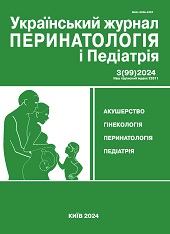Analysis of complications of pregnancy, childbirth, the postpartum period and extragenital morbidity in pregnant women in Ukraine and forecasting the dynamics of selected indicators until 2026
DOI:
https://doi.org/10.15574/PP.2024.3(99).1324Keywords:
obstetric and gynecological care, extragenital morbidity, complications of pregnancy, maternal mortality, childbirthAbstract
Aim - evaluation of the quality of obstetric care in Ukraine and forecasting the dynamics of intranatal morbidity and complications of the postpartum period for the period until 2026.
Materials and methods. Statistical data of healthcare institutions of Ukraine for the period 2011-2022 were analyzed. One-factor linear regression models were used for mathematical modeling. Calculations by MedCalc® Statistical Software version 22.009.
Results. According to the data of the conducted analysis, the following stable trends were revealed: a decrease in the total number of births from 491,467 to 195,243; decrease in the share of physiological births from 68.6% to 61.6%; an increase in the number of multiple pregnancies (calculations per 1,000 pregnancies) from 10 to 13 per 1,000; number of pathological venous conditions from 25 to 50; number of gestational and pre-gestational diabetes from 1 to 10; the number of infections of the genitourinary system from 134 to 143. Pathologies of the circulatory system and diseases of the thyroid gland do not have a tendency to increase. The analysis of indicators related to childbirth revealed a significant increase in cesarean delivery from 16.17% to 27.43% with a further increase to 31.4% in 2026, an increase in the level of bleeding from 7.3 to 9.9 and the number of complicated births from 58 to 70 (the figures are calculated for 1000 births).
Conclusions. During the period of analysis, no significant deterioration in the quality of obstetric care was found, however, there are a number of negative trends, namely, an increase in the frequency of difficult childbirth and cesarean delivery. In the near future, we should expect a decrease in the total number of births, a decrease in the share of physiological births, an increase in the frequency of pre-existing somatic diseases and pregnancy complications, and an increase in the specific gravity of multiple pregnancies. The result will be a further increase in cesarean deliveries, and an increase in the frequency of abnormal placentation and associated heavy bleeding. The key approaches to managing the identified trends are the development and implementation of algorithms for timely detection of pregnant women at risk of developing perinatal and obstetric complications and optimal routing of pregnant women who are included in the formed risk groups for the occurrence of severe obstetric and perinatal pathology.
The authors declare no conflict of interest.
References
Betran AP, Ye J, Moller AB, Souza JP, Zhang J. (2021, Jun). Trends and projections of caesarean section rates: global and regional estimates. BMJ Glob Health. 6(6): e005671. https://doi.org/10.1136/bmjgh-2021-005671; PMid:34130991 PMCid:PMC8208001
Blencowe H, Cousens S, Oestergaard MZ, Chou D, Moller AB, Narwal R et al. (2012, Jun 9). National, regional, and worldwide estimates of preterm birth rates in the year 2010 with time trends since 1990 for selected countries: a systematic analysis and implications. Lancet. 379(9832): 2162-2172. https://doi.org/10.1016/S0140-6736(12)60820-4; PMid:22682464
Fink DA, Kilday D, Cao Z, Larson K, Smith A, Lipkin C et al. (2023, Jun 1). Trends in Maternal Mortality and Severe Maternal Morbidity During Delivery-Related Hospitalizations in the United States, 2008 to 2021. JAMA Netw Open. 6(6): e2317641. https://doi.org/10.1001/jamanetworkopen.2023.17641; PMid:37347486 PMCid:PMC10288331
Goldenberg RL, Culhane JF, Iams JD, Romero R. (2008, Jan 5). Epidemiology and causes of preterm birth. Lancet. 371(9606): 75-84. PMCID: PMC7134569. https://doi.org/10.1016/S0140-6736(08)60074-4; PMid:18177778
Institute of Medicine (US) Committee on Understanding Premature Birth and Assuring Healthy Outcomes, Behrman RE, Butler AS. (2007). Preterm Birth: Causes, Consequences, and Prevention. Behrman RE, Butler AS, editors. Washington (DC): National Academies Press (US). PMID: 20669423. https://doi.org/10.17226/11622
Liu L, Oza S, Hogan D, Chu Y, Perin J, Zhu J et al. (2016, Dec 17). Global, regional, and national causes of under-5 mortality in 2000-15: an updated systematic analysis with implications for the Sustainable Development Goals. Lancet. 388(10063): 3027-3035. doi: 10.1016/S0140-6736(16)31593-8. Epub 2016 Nov 11. Erratum in: Lancet. 2017 May 13; 389(10082): 1884. https://doi.org/10.1016/S0140-6736(17)31212-6; PMid:28513451
Moiseienko RO, Gojda NG, Dudina OO, Bodnaruk NM. (2021). Development of perinatal medicine in Ukraine in the context of international approaches. Wiad Lek. 74; 3 cz 2: 761-766. https://doi.org/10.36740/WLek202103237; PMid:33843650
Mwaniki MK, Atieno M, Lawn JE, Newton CR. (2012). Long-term neurodevelopmental outcomes after intrauterine and neonatal insults: A systematic review. Lancet. 379: 445-452. https://doi.org/10.1016/S0140-6736(11)61577-8; PMid:22244654
Rogach IM, Slabkiy GO, Pogorilyak RY at al. (2020). Perinatal and infant mortality in the transcarpathian region and ukraine against the background of the european union and the world: a comparative analysis and possible problems. Wiad Lek. 73(3): 603-608. https://doi.org/10.36740/WLek202003138; PMid:32285842
Romero R, Dey SK, Fisher SJ. (2014, Aug 15). Preterm labor: one syndrome, many causes. Science. 345(6198): 760-765. Epub 2014 Aug 14. https://doi.org/10.1126/science.1251816; PMid:25124429 PMCid:PMC4191866
World Health Organization (WHO) Maternal & newborn mortality morbidity Data base: https://platform.who.int/mortality/themes/theme-details/MDB/communicable-maternal-perinatal-and-nutritional-conditions
Downloads
Published
Issue
Section
License
Copyright (c) 2024 Ukrainian Journal of Perinatology and Pediatrics

This work is licensed under a Creative Commons Attribution-NonCommercial 4.0 International License.
The policy of the Journal “Ukrainian Journal of Perinatology and Pediatrics” is compatible with the vast majority of funders' of open access and self-archiving policies. The journal provides immediate open access route being convinced that everyone – not only scientists - can benefit from research results, and publishes articles exclusively under open access distribution, with a Creative Commons Attribution-Noncommercial 4.0 international license(СС BY-NC).
Authors transfer the copyright to the Journal “MODERN PEDIATRICS. UKRAINE” when the manuscript is accepted for publication. Authors declare that this manuscript has not been published nor is under simultaneous consideration for publication elsewhere. After publication, the articles become freely available on-line to the public.
Readers have the right to use, distribute, and reproduce articles in any medium, provided the articles and the journal are properly cited.
The use of published materials for commercial purposes is strongly prohibited.

